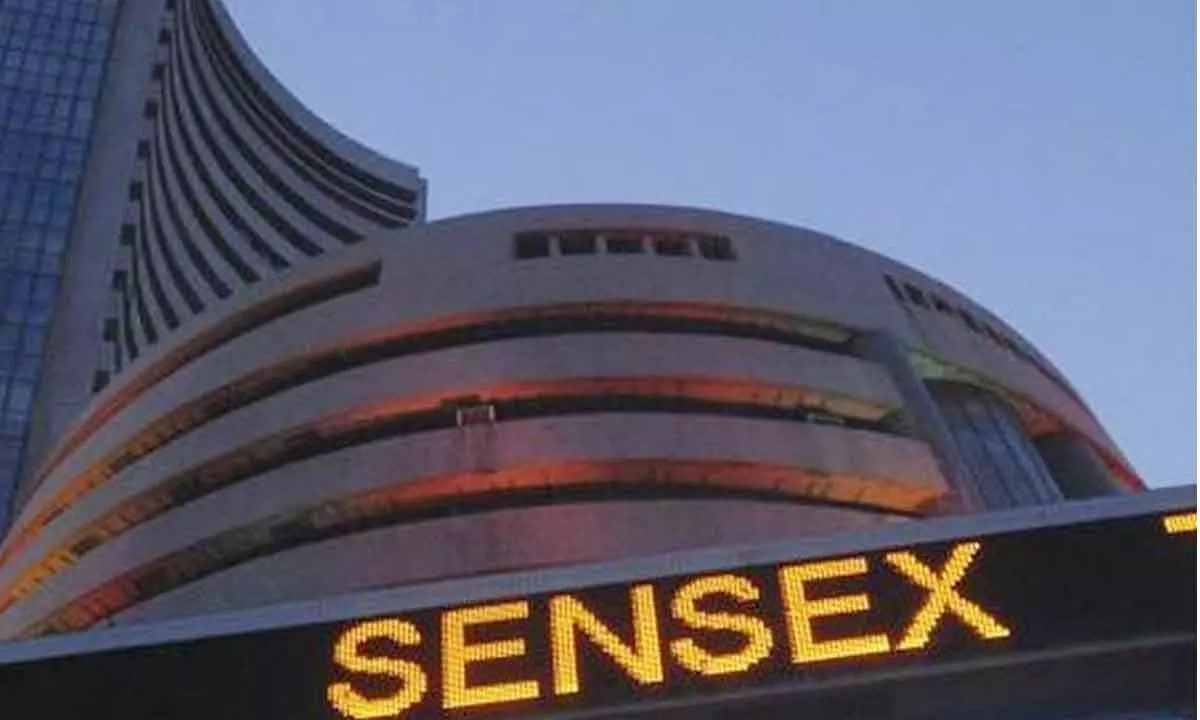Investors look to fresh triggers from macro data

BSE Sensex
The central bank also maintained its full-year inflation forecast at 6.7%, but lowered its growth estimates to 7% from 7.2%
Selling pressure continued for the third successive week as recession fears deepened in the West, with the Indian equity benchmarks falling more than one percent during the week ended. The stellar rally on September 30 after the RBI as expected raised the repo rate by 50 basis points to 5.9 percent has curtailed some of the losses. BSE Sensex plunged 672 points to 57,427, while NSE Nifty tanked 233 points to 17,094. Broader markets also traded in line with the benchmark indices with the Nifty Midcap-100 and Smallcap-100 indices declining by 1.3 percent and 1.5 percent. The rupee, which depreciated by 221 paise in the last two-and-a-half weeks, is expected to remain within the broad range of 80-82 levels in the coming days. A weak US dollar and overall weak tone in crude oil prices may also support the rupee. The US dollar index, which measures the value of the American currency against a basket of world's leading six currencies, fell from a fresh 20-year high of 114.78 to 112.12 during the week.
With rising bond yields and further policy tightening, FIIs have once again started withdrawing money from India. They net sold nearly Rs15,900 crore worth of shares last week, taking the monthly outflow to over Rs18,300 crore against Rs22,000 crore of buying in the previous month. DIIs supported the market by aggressive purchases buying more than Rs14,000 crore worth of shares in the passing month. On Monday, the market will first react to monthly auto sales numbers released over the weekend. It's going to be tough for markets to build on Friday's rebound amid feeble global cues. The central bank also maintained its full-year inflation forecast at 6.7 percent, but lowered its growth estimates to seven percent from 7.2 percent. During the week ahead, given the volatility and subdued global environment, the market will focus on manufacturing & services data, the currency trend and will gradually shift attention to Q2 earnings season. It will be a holiday-shortened week as the market will remain closed on October 5 on account of Dussehra.
Listening Post: The relentless plunge in China's stocks has boosted the appeal of their biggest emerging-market rival India, spurring a divergence that's rarely been seen before. The MSCI India Index rallied almost 10 per cent in the just-ended quarter, compared with a 23 per cent slump for the MSCI China Index. The 33-percentage point outperformance by the India gauge is the biggest since March 2000. India's expanding domestic market means the country can weather a looming global recession better than most other emerging markets, money managers say. In the longer term, China's decoupling with the US may also pave the way for Indian firms to boost their presence worldwide. China's 'draconian lockdowns continue to impact these supply chains, so the clamor for an alternative has been rapidly gaining favour. India is the key candidate to fill that role, in an approach that's been dubbed as China+1.
The big divergence between the two stock markets started to take place in February 2021 as tightening liquidity conditions in China contributed to the unwinding of a two-year rally in equities. Indian stocks, meanwhile, kept hitting record highs thanks to an unprecedented retail investing boom.
The aggregate market value of firms included in the MSCI China Index has dropped by $5.1 trillion since then and the gauge closed Friday at its lowest level since July 2016. The MSCI India Index -- which reached an all-time high earlier this year -- has added about $300 billion. A long-term correlation between the two gauges has been negative since November, the longest stretch on record. Investor positioning has also diverged. Some of the barriers to investing in China appear to be structural and longer lasting than expected. To be sure, months of outperformance has made Indian stocks the most expensive in Asia on an earnings-based valuation. This has yielded caution from some investors, with the Reserve Bank of India's (RBI) interest-rate hikes also a factor that could weigh on market outlook. India's large and younger population coupled with a favourable environment toward private enterprise means it will be growing faster than China in the coming years.
Major global companies have been taking advantage of the South Asian country's industrial prowess. Apple Inc, which has long manufactured most of its iPhones in China, began making its new iPhone 14 in India sooner than anticipated following a smooth production rollout. Citigroup Inc is targeting India as one of its top markets to expand globally. With its rising market clout, India's weight in the MSCI Emerging Markets Index has increased by almost 7 percentage points in the two years through September. Meanwhile, that of Chinese and Hong Kong stocks combined has fallen by more than 10 points. As a stock market, India is home to some of the highest quality companies in the region, with some of the most capable management teams anywhere in Asia Segments where India excels include financial services, consumer goods and services and health care.
Quote of the week: "It's not whether you're right or wrong that's important, but how much money you make when you're right and how much you lose when you're wrong." — George Soros
Too many investors become obsessed with being right, even when the gains are small. Winning big and cutting your losses when you're wrong are more important than being right.
F&O / SECTOR WATCH
On the back of global cues, the settlement week witnessed heightened volatilityin the derivatives segment. Rollovers in Nifty futures were at 78% (last month 82%), in line with 3-month average of 78%.On other hand, market wide rollovers stood at 93% (last month's market wide 92%).The maximum Call Open Interest (OI) was seen at 18,000 strike, which can be crucial resistance for the Nifty in the October series followed by 17,500 strike, with Call writing at 17,100, 17,500 & 17,200 strikes. The maximum Put OI was seen at 16,000 strike, which can be significant support point in the current F&O series followed by 17,000 and 16,500 strikes, with Put writing at 17,100, 16,800 and 16,700 strikes. The options data indicates that the Nifty will see a broader trading range of 16,500 to 17,600, while in the immediate term, the range could be between 16,700 and 17,500. Technically both the indices i.e Nifty and Bank Nifty still managed to hold above their 200Day Exponential Moving Average on daily charts and expected to trade sideways in the upcoming week. Implied Volatility (IV) of Calls closed at 20.37 per cent, while that for Put options closed at 21.64 per cent. The Nifty VIX for the week closed at 21.3 per cent. PCR of OI for the week closed at 1.27 lower than the previous week. On higher side, 17200 to 17300 zone is likely to act as resistance zone for the Nifty while 16900-16700 zone is likely to provide support on any downside. Expect that volatility to continue and bias will remain in favour of bulls as far Nifty holds above 16800 level. Focussing on five key components-earnings, fundamentals, relative valuation, risk and price momentum; companies that hold promise are Amara Raja and Exide. The advent of 5G wireless broadband technology would drive creation of 5G use cases and give a boost to entrepreneurial spirits. Stay invested in the sector. One dark horse bet can be Vodafone India.
Stock futures looking good are Bharti Airtel, Havells, Jubilant Food, Federal Bank, Marico and Tata Chemicals.Stock futures looking weak areBerger Paints, IGL, Gujarat Gas, Lal Path labs, Torrent Power and Naukri.














